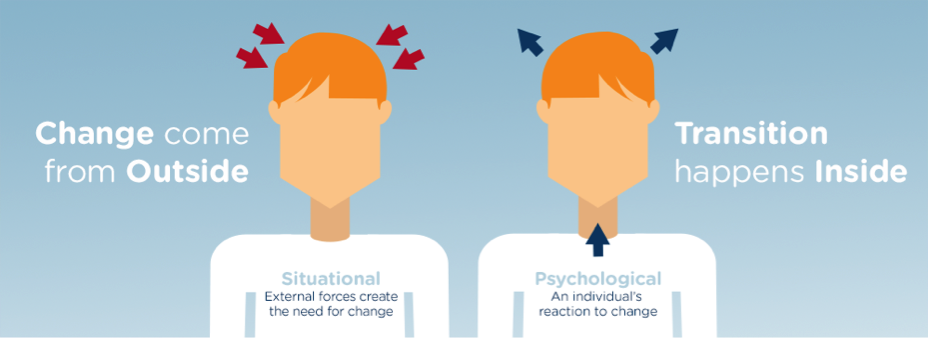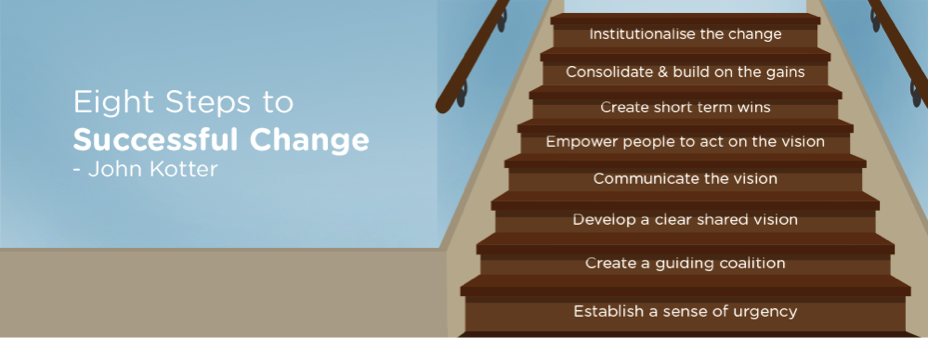Manage Organizational Change
Learning Objectives
After completing this unit, you’ll be able to:
- Recognize the human element as critical to organizational change.
- Describe a best-practice approach for leading organizational change.
Focus on the Human Element

Once we’ve identified the changes we need to make, then we need to act. However, successfully changing an organization involves more than identifying changes to products, the org-chart, operational processes, and the like. It involves helping people transition. According to Peter Drucker, people are unlike any other resources in an organization. When making changes, consider their unique psychological characteristics. After all, people ultimately control how hard and how well they work, so it’s best to have them on board.
|
“…management deals with the behavior of people and human institutions.”
—Peter F. Drucker |
|---|
It’s a reality that some people won’t recognize the need for change, agree with your proposal, or accept them even if they know they’re needed and coming. Other people can logically agree but worry that the changes will affect them personally or professionally. They can even passively, or actively, sabotage your efforts. If we approach things right, we can get people energized and enthusiastic about changes by:
- Managing the process of making the changes (new procedures and structures, and so on)
- Helping people transition to the new model
For example, the Bridges model describes how people can respond to changes during a transition, and how people can move through different stages that affect performance. People can have unique reactions to change. But by anticipating reactions, change managers can help them transition as quickly and seamlessly as possible to keep the organization functioning at a high level of performance.

The Bridges model describes change as coming from the outside, requiring people to transition over time through different stages that could affect their productivity. If managed correctly, people can transition to an engaged, high-energy state.
Climb Eight Steps to Organizational Change
A good framework for helping an organization through the change process is Kotter’s Eight Steps—developed by Harvard Business School professor John Kotter. If you work in a medium- to large-size organization that has undergone changes, then you may recognize this approach. One of the nice things about the Kotter’s Eight Steps is that almost any organization can use it.

Step 1: Establish a Sense of Urgency

Create a sense of urgency in the organization regarding the need for change and overcome complacency. Paint a picture of a major opportunity, or even a looming crisis, in a way that gets people moving. Get people thinking about the need for change, and establish the foundation to bring people together. To accomplish this, leaders will often send out a series of announcements over a period of weeks describing the conditions or opportunities to change.
Tip: Use Slack to communicate the need for change across the organization.
Step 2: Form a Powerful Guiding Coalition

Set up teams of people willing to implement the changes by working across departments and layers—to improve cross-silo communications. Identify and engage key managers and stakeholders who are able and willing to start working on the changes. Getting key people on board greatly increases the potential for success.
Tip: Create a Slack channel to help team members work effectively across departments and layers.
Step 3: Create a Vision

Craft a clear and compelling vision—one that people can easily understand, and that inspires people to help with the changes. Accompany the vision with strategies and plans to show how the vision is to be achieved. Done well, the vision and plans are believable. Audacious visions and plans are fine, but unbelievable visions or nonviable plans are not inspiring—they hurt your chances of success.
Tip: Identify customer information in Salesforce that can help your organization craft a compelling vision.
Step 4: Communicate the Vision

Repeatedly communicate the vision throughout the organization—to any and all who’ll listen. Repetition is essential to:
- Ensure everyone’s fully aware of the changes.
- Get everyone on board.
- Let people know the change isn’t going away.
Some organizations develop complete communication plans—similar to internal marketing plans. Remember, actions often speak louder than words, so having key people or groups model the desired behavior can be powerful communication (the reverse is true too).
Tip: Do more than send out a few mass emails announcing the changes. Mix it up with fun video blogs, breakroom flyers, and other creative communications. Create Slack posts tailored specifically for key groups.
Step 5: Empower Others to Act on the Vision

Before people can act on the vision, find and remove obstacles. These could be compensation plans or metrics that reward the wrong or old behaviors, cumbersome approval processes, overly controlling managers, or restrictive job descriptions.
Tips: Have members of your executive team recognize early adopters—this helps others understand the importance of the change effort. Have your champions work together to develop and share best practices to increase ownership. Use Slack to publically recognize and reward people and teams for exhibiting desired behaviors—foster a sense of community across the organization.
Step 6: Plan for and Create Short-Term Wins

The change process can take some time to complete, so it’s often a good idea to start by breaking it down into smaller parts. Pick and execute one part early to establish a quick win—celebrate the successes and make sure everyone knows about it. This approach helps make the change process more real for people in the organization, especially for those who haven’t yet fully committed.
Tip: Is there an opportunity to use Salesforce capabilities to create a quick win? Have your super users across the organization help identify and create the win. They can also spread the word about how awesome the changes are and help drive acceptance and adoption.
Step 7: Build on the Change

Continue to execute your plan by building on your wins—expanding changes as appropriate. With each success or failure, be sure to work with stakeholders to find out what went right and what didn’t. Know that some of your early assumptions may not come true. Your organization must recalibrate during the transformation.
Tip: After each major milestone, make the time to have a postmortem meeting with the change team to discuss what worked, what didn’t, and what you would change. Then adjust your plans accordingly.
Step 8: Institutionalize New Approaches
Embed the changes into your organization so they can’t be easily undone. In other words, make the new strategies, processes, and policies part of the daily fabric of the organization. That way they continue to exist long after the change leadership team’s work is done.
Use a system to help you align the vision and mission of the organization with objectives. For example, at Salesforce, alignment is done through a process known as V2MOM—vision, values, method, obstacles, and measures.
Tip: Develop processes and procedures for making sure the changes stick over time. For example, create refresher training and other resources that are available long after the change team has moved on to other efforts. Think about how Salesforce can help institutionalize the changes at your organization—adopt the mantra, “If it’s not in Salesforce, it didn’t happen.”
Summary
In this unit, we examined the importance of focusing on the human element, and Kotter’s Eight Steps approach for managing organizational change. In the next unit, we take a look at an example of an organization that recognized the need to change, and used technology to enable the process.
Resources
